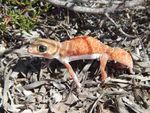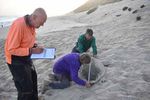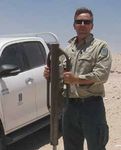Wirruwana News - Parks and Wildlife Service
←
→
Page content transcription
If your browser does not render page correctly, please read the page content below
GOVERNMENT OF
WESTERN AUSTRALIA
Wirruwana News
Updates From Dirk Hartog Island National Park
AUTUMN 2020
This fifth edition of Wirruwana News covers the exciting new chapter in the ten-year saga of Dirk Hartog Island National Park’s
Return to 1616 Ecological Restoration Project with two new native animals being restored to the island. Enter the humble dibbler
(Parantechinus apicalis) and the smallest of all bandicoots – the Shark Bay bandicoot (Perameles bougainville).
Going where no Jurien Bay dibbler has gone before
October 7th 2019 saw another exciting “first” on Dirk Hartog
Island National Park with the release of the long awaited
dibblers (Parantechinus apicalis).
Once widespread around coastal WA from Shark Bay south
and across to Esperance, dibblers now only exist in a few
island and mainland populations. Dirk Hartog Island is large,
free from feral predators and has vegetation that is rapidly
regrowing after feral goat and sheep removal. This makes it
the perfect “island escape” for our dibbler ambassadors and
represents a golden opportunity to help safeguard this unique
carnivorous marsupial.
This first wave of island immigrants consisted of 26 dibblers.
Parents of these dibblers originated from islands off Jurien
Bay before being paired up at Perth Zoo to produce enough
offspring to begin the restoration process on Dirk Hartog
Principal Research Scientist Dr Tony Friend releases
Island. a dibbler with Sanchia Wardle and Ruby Ball.
Born in May, the young dibblers were weaned in late Photo – Kieran Wardle
September in preparation for the world outside their leaf
litter lined glass tanks. Their first-class trip to the island was a A volley of enthusiastic assistants were on hand to help open
massive organisational feat. First came their last free meal in the travelling boxes when our dibblers arrived. With front row
captivity before each dibbler was assigned the luxurious travel seats, helpers enjoyed the rare privilege of watching dibblers
accommodation of individual aluminium boxes (Elliot traps) put on a good show of rustling through the leaf litter and
lined with a comfortable layer of shredded paper. Whisked to hunting for insects before scampering off into the scrub.
Jandakot airport at midday, they caught a specially chartered,
air-conditioned flight to Denham before boarding a helicopter Some of the dibblers were fitted with miniature radio-collars
for the last leg of their journey. A scant 6 hours after leaving but proved wily enough to remove them early on. Despite
Perth Zoo and 800km later, the dibblers arrived at their new this, some valuable information on survival and dispersal was
home. gained with one male travelling a whopping 1.7km in only
two nights! He was clearly glad to be out of his glass tank.
Although the island is free of feral predators, dibblers are
still at risk from native birds of prey so their release site had Although Elliott traps and camera traps will be used to
been carefully chosen for the abundance of the aptly named monitor dibblers, with the island’s large size, it may be some
umbrella bush (Acacia ligulata). This wattle provides both time before the population increases to a point where
ample protection from overhead predators and a thick layer individuals are regularly caught. Further releases and breeding
of leaf litter underneath that is rich in insects for our hungry amongst the island dibblers will increase the chances of
pioneers. finding dibblers in future.Wirruwana News Updates From Dirk Hartog Island | AUTUMN 2020
Loggerhead female heads back to the ocean after a hard night’s work. Photo – Khayla Wordsworth/DBCA
Turtle Tagging Time
As the annual breeding migration of loggerhead turtles (Caretta and shopping bags can look a lot like jellyfish. When eaten by
caretta) to Dirk Hartog Island National Park got underway this turtles, it has dire consequences and plastic ingestion is a major
year, so too began the twin migration of volunteers to help with contributor to turtle deaths each year. So hang onto your plastic
WA’s longest running project to study them. Getting up close when it’s windy and try to reduce or eliminate your plastic use
and personal with a truly unique marine turtle is a fabulous altogether when you’re out and about boating or camping.
opportunity for volunteers who come from near and far to join
Pets aren’t permitted in the national park and for good reason.
in.
Dogs can interfere with hatchlings and disturb females laying
Loggerhead turtles are the second largest marine turtle in the eggs so leave the pets behind when heading out.
world and the vast majority of WA’s loggerheads nest in Shark
Artificial light can cause female turtles to abandon the nest
Bay. Dirk Hartog Island has WA’s highest density and population
when laying eggs and interfere with hatchlings ability to
of nesting turtles, is thankfully free of feral animals and has very
navigate so if you see a turtle on the beach, turn off the torch
little human disturbance which makes it a critically important
and the flash on your camera.
site for their survival.
Volunteer work is hard but rewarding and volunteer positions
Between 1000 – 1200 turtles nest on Dirk Hartog Island in
are limited. If you have a high level of fitness and would like to
breeding season each year between November and April.
“put your hat in the ring” to help out in future years, you can
For three weeks each January, volunteers work all night,
request to be included on the volunteer register. Email enquiries
walking along the beaches and rocky shores of Dirk Hartog
to: sharkbayenquiries@dbca.wa.gov.au
Island to locate the turtles. Turtles are tagged so they can be
identified when they return to the beach and volunteers collect
information which can be used to gain a better understanding
of turtle ecology. As the volunteers labour to collect
information each night, female turtles perform the herculean
task of heaving their heavy bodies up the beach to dig a hole
and lay between 50 and 100 eggs. Each day volunteers count
the drag marks to help estimate population numbers.
The loggerhead turtle is the most endangered turtle nesting
in Australia and they are vulnerable the world over as a result
of many threats including loss of nesting areas, nest predation,
plastic pollution, disorientation from coastal lighting and being
caught by long lines and trawling nets. But with a few simple
measures, we can all help.
Along with crustaceans and molluscs, turtles eat jellyfish.
Volunteer David Lergessner records the vital statistics of a Loggerhead
Unfortunately, plastics floating in the ocean including bait bags turtle. Photo – Khayla Wordsworth/DBCAGypsies on the Move!
In October 2019, a tour group called the Global Gypsies As a change of pace, the gypsies also conducted two beach
journeyed to Dirk Hartog Island, some 403 years after the cleanup sessions, one at Surf Point and one at Mystery Beach.
eponymous explorer Dirk Hartog left behind his famous pewter
It wasn’t all hard work though as ‘voluntourists’ were on
plate. With exploration of a different kind in mind, these Global
a roster system to ensure they still had plenty of time for
Gypsy ‘voluntourists’ were in search of a ‘hands on’ science
beach-combing, swimming, snorkeling, kayaking, fishing, bird
safari to assist Parks and Wildlife Service scientists with the Dirk
watching, astronomy, photography, four-wheel driving, relaxing
Hartog Island National Park Ecological Restoration Project –
and just having fun.
Return to 1616.
For the gypsies, it was an all-round great way to holiday in
Contributing to a long-term, vertebrate animal monitoring
WA while helping to conserve our precious native wildlife. In
program, expedition members helped to set up pitfall traps and
addition, the Global Gypsy tours are a gift that keeps on giving
then assisted with trapping, recording and release of a range
as part proceeds are donated back to the Parks and Wildlife
of animals including dragons, geckoes and native mice. This
Service to assist with future conservation efforts.
program has been running for 13 years and was set up to study
the changes in vertebrate animal numbers before and after the Below left: Knob-tailed gecko (Nephrurus levis occidentalis). Photo –
Global Gypsies. Below: Processing of captured animals and recording
removal of feral animals on the island and the translocation of
of details. Photo – Bryan Mitchell
native animals.
Ranger Report
DBCA Rangers continue regular patrols on Dirk Hartog Island National Park
to foster awareness of environmental and World Heritage values, maintain
facilities and follow-up with compliance matters. Shark Bay District staff recently
welcomed new National Park Ranger Paul Robb, who brings a wealth of
conservation experience to the position and will be working across Dirk Hartog
Island and several other national parks in the district.
A bit of a trail blazer, Paul was the first ranger to be appointed to the remote
Karara Rangeland Park based at Thundelarra. Situated 300km east of Geraldton,
Paul has been in this position for the last three years, so he’s no stranger to remote
conditions.
Prior to Karara, Paul worked as a ranger south of Jurien Bay – along the coastal
strip that includes Nambung National Park and Wedge Island settlement. Paul’s
professional experience includes feral animal and declared weed control. He has
already brought these talents to bear in Shark Bay some years ago, having been New National Park Ranger Paul Robb on
one of the shooting team that helped eradicate goats from Dirk Hartog Island Dirk Hartog Island.
National Park.
Paul is a committed environmental practitioner and is enjoying the opportunity to be part of the local community in
Shark Bay.
In other ranger news, visitor feedback has been positive regarding the new toilet built at Withnell Point camp site. Modelled
on the same design as toilets constructed at Urchin Point and West Point, the toilet includes a raised mesh floor (no sweeping!)
and a shower recess for portable showers.Wirruwana News Updates From Dirk Hartog Island | AUTUMN 2020
Hare-wallabies to bandicoots – moving explorers, venturing as far as 4km. When finally caught for
collar removal, all bandicoots were found to be in very good
right along! health. Some maintained their weight, but most had put on
weight including one animal that gained a whopping 20% of
With the coming of spring 2019, the Return to 1616 fauna
its body weight. That’s equivalent to a 65kg person tipping
team travelled back to Dirk Hartog Island National Park in
the scales at 78kg after a month-long binge! Clearly the glut of
anticipation of another season of ecosystem restoration work.
spring insects went down very well. Even more exciting was
Of the 13 species to be translocated over the life of the project, the discovery of two females carrying “DHI next generation”
the newly established populations of banded and rufous pouch young.
hare-wallabies are doing well. With the full quota of banded
The good news was that by November, there was an
hare-wallabies being reached in 2019, that left only a few
extraordinary abundance of bandicoot tracks and diggings
more “top up” rufous hare-wallabies to make the journey to
to be found that clearly indicated a thriving population. The
Dirk Hartog Island this year. A total of 50 made the move from
bad news was they were obviously far too well-fed on insects,
nearby Bernier and Dorre Islands, bringing the total number of
and none could be tempted into a trap for a delicious meal
translocated rufous hare-wallabies to 112 over the past three
of peanut butter and oats. Undeterred, the fauna team will
years. These kangaroo “Mini-Me’s” are very highly strung and
be back in March with some new tricks up their sleeve, which
the team needed to be extremely careful to minimise stress
promises exciting times ahead!
to these animals including organising fast first-class helicopter
transport for the island hop. The extra attention paid off
though as the hare-wallabies were all well, healthy and ready
to go when released into their new home.
With successful hare-wallaby translocations, the fauna team
turned their attentions to the Shark Bay bandicoots (Perameles
bougainville).
Working at night with hand-nets and spotlights, the capture
team had remarkable success resulting in a total of 70 ‘coots’
in only a few weeks from Bernier and Dorre Islands. Bernier
Island was by far the trickier proposition as it harbours a
disease called Bandicoot Papillomatosis Carcinomatosis Virus Above: Shark Bay bandicoot being released into its new home.
1 (BPCV1) and the team had to be extremely vigilant to select Below: DBCA staff member Jeff Brooker was delighted to discover so
only healthy animals. Sadly, any bandicoots showing any many bandicoot tracks
symptoms of the disease such as lesions or warts were rejected
and missed out on their all-expenses-paid one-way trip to Dirk
Hartog Island.
The bandicoots were released in the Herald Bay area in
early September where there is abundant vegetation. They
clearly settled in very well as within 12 hours of the first
bandicoot release, their tracks and diggings were to be found
everywhere! Twelve of the bandicoots were given radio-collars
and tracked for 4 to 7 weeks. While some remained very
loyal to their release sites, others were quite clearly natural
Contributors and photos: Principal Research Scientists Dr Tony Friend,
Return to 1616 Research Scientist Dr Saul Cowen, Parks and Visitor Scan this QR code to
Services Coordinator Gavan Mullan, Voluntourist Bryan Mitchell. Editor keep up to date with
Wendy Payne. what’s happening with
the Dirk Hartog Island
Contributions to this biannual newsletter from outside the Return to 1616
National Park Ecological
project are welcome.
Restoration Project –
The Return to 1616 project is funded by the Gorgon Barrow Island Net Return to 1616
Conservation Benefits Fund.
2020_99 0220
GOVERNMENT OF
WESTERN AUSTRALIAYou can also read
























































